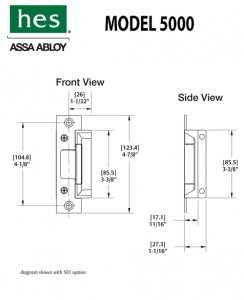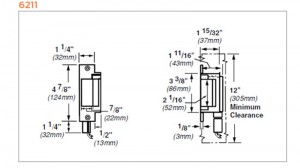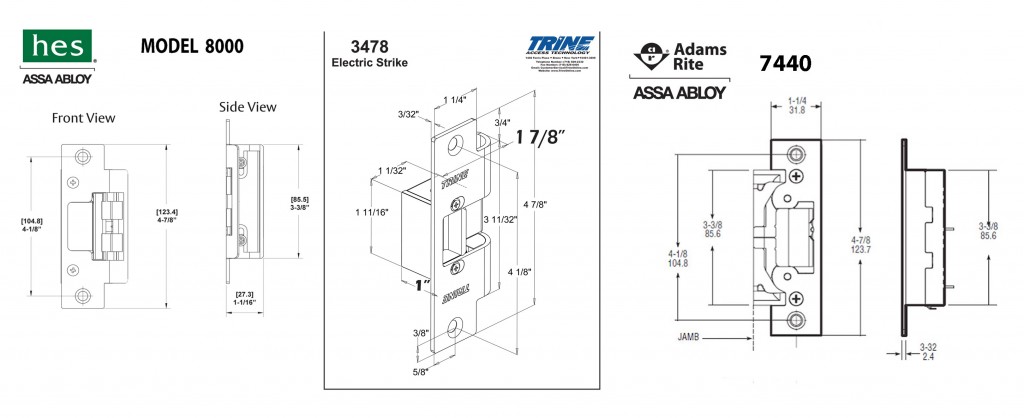A common problem with installing electric strikes is cavity depth – that is, how deeply you need to cut into the frame (or wall) so that the electric strike will fit. For most of the twentieth century electric strikes were, and most still are, designed without consideration for this factor. Instead they are designed for burglary resistance and durability.
Click on the dimensional diagram of the Von Duprin 6211 electric strike at right. You can see that its total depth is 1-11/16 inches. All of its internal parts are heavy duty, and it has a heavy cast body and a thick, finished face plate. Most of the parts are individually replaceable. To install the 6211 in a hollow metal door frame, the dust box must be removed and often material inside the door frame – sheet rock, wood, masonry, whatever – must be removed in order to accommodate the strike. If the strike must be installed in a grouted door frame the installer is in for perhaps an hour’s worth of work that may involve a masonry drill, a 2-1/2 lb. sledge hammer, a masonry chisel and safety goggles.
 In more recent years a new generation of low profile (shallow depth) electric strikes has become available, offering unprecedented ease of installation. The HES 5000 (illustration at left) was one of the first strikes on the scene to offer a depth of only 1-1/16 inches, and advertised that it could be installed without even removing the dust box from the frame. I have found it is usually much easier to knock out the dust box for wiring reasons, but it is true that the unit will fit neatly inside most original equipment dust boxes in hollow metal frames.
In more recent years a new generation of low profile (shallow depth) electric strikes has become available, offering unprecedented ease of installation. The HES 5000 (illustration at left) was one of the first strikes on the scene to offer a depth of only 1-1/16 inches, and advertised that it could be installed without even removing the dust box from the frame. I have found it is usually much easier to knock out the dust box for wiring reasons, but it is true that the unit will fit neatly inside most original equipment dust boxes in hollow metal frames.
More recent offerings in the shallow depth electric strike department include the Trine 3478, the HES 8000 and the Adams Rite 7440, illustrations shown at the end of this article. All are UL Listed burglary resistant. The HES 8000 offers 1500 lbs. holding force, the 3478 offers 1200 lbs. holding force and the Adams Rite, with its innovative double keeper design, offers 2400 lbs. of holding force. The Trine 3478 offers an install with a very tiny lip cutout, and the HES 8000 offers the advantage of needing no lip cutout at all. Each of them fit in a strike cavity only 1-1/16 inches deep.
These strikes have revolutionized electric strike installation. Before, a good installer might install six or ten electric strikes in a day. Now a really fast installer might be able to install 20 or more, greatly reducing labor and other costs associated with installation.
What’s the Trade-Off?
None of the internal parts of these strikes are available. When these strikes break, you throw them away and buy new ones. Also they do not last as long. Whereas it is not unusual to see a Von Duprin 6211 or a Folger Adam 712 still in use after 10 or even 20 years, 6 years of service is a long time for a low profile strike. In ten years you might be replacing a spring or solenoid in a Von Duprin, but you might be installing your second or third low profile strike in the same door frame in that same amount of time. This is a small inconvenience.
Upon installing that third strike in the same hole, you probably will not yet have equaled the price of a single Folger Adam 712 or Von Duprin 6211. If price up front is the primary consideration, low profile is definitely the way to go. But if in about 12 years you are installing the fourth replacement strike in the same prep, those expensive, harder-to-install, heavy duty strikes start to look like a much better value.
HES model 8000, Trine model 3478 and Adams Rite model 7440
Thank you.
access control, door hardware, electric locking, electric strike, electronic security, fail safe, fail secure, security hardware



{ Comments are closed! }